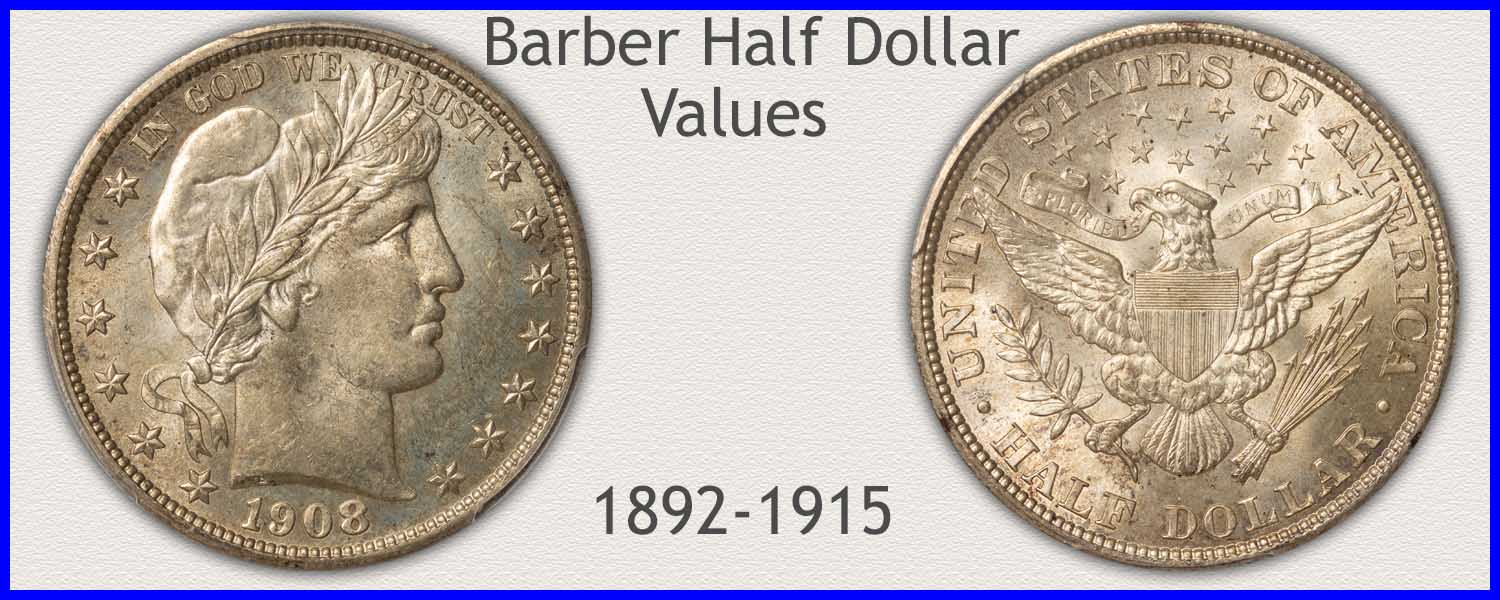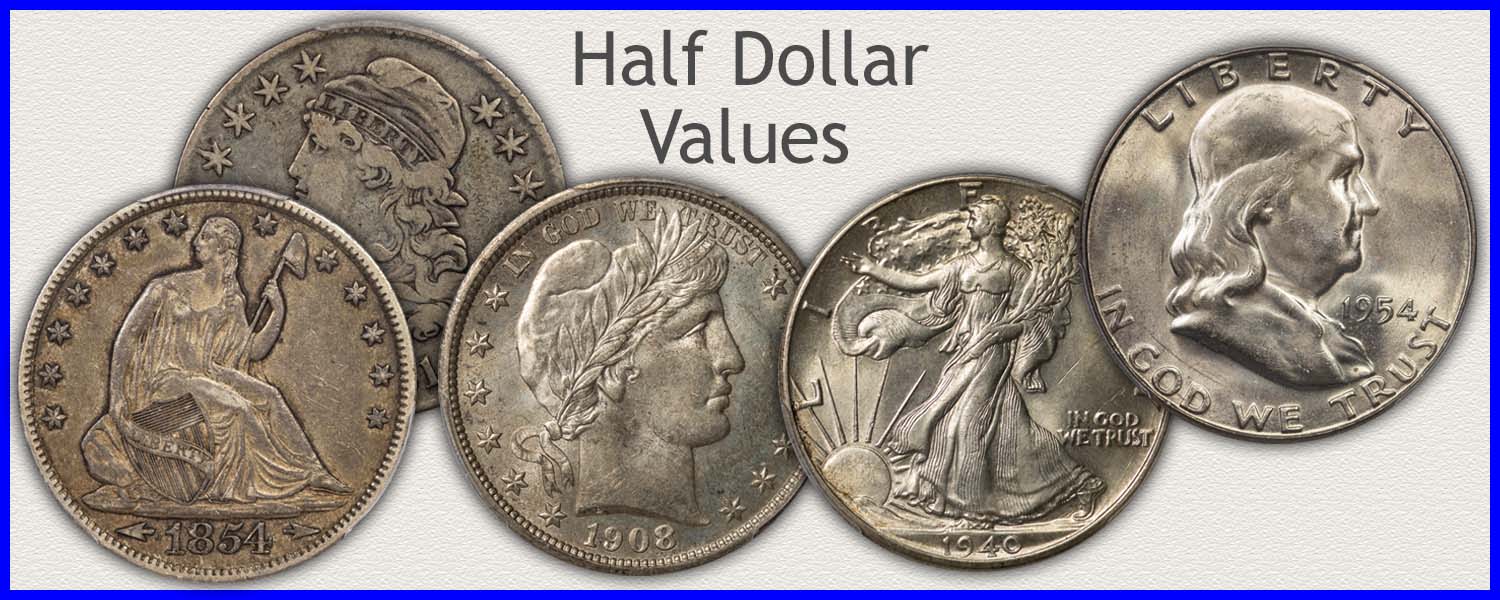Coin Values Moving with Precious Metals: Up-Dated 4/7/2025: Gold $3035 | Silver $30.08
1899 Half Dollar Value
1899 half dollar value is at a premium for examples in above average condition. These coins are 90% silver by weight and have a high intrinsic worth.
Additionally, special collector value is placed on coins that have been well preserved. A Barber half is now considered a very old coin, belonging to an obsolete series. Today's collectors value them based on the date and mint combination, and in nice condition, they are in demand. To establish its position on the chart, follow the steps outlined below.
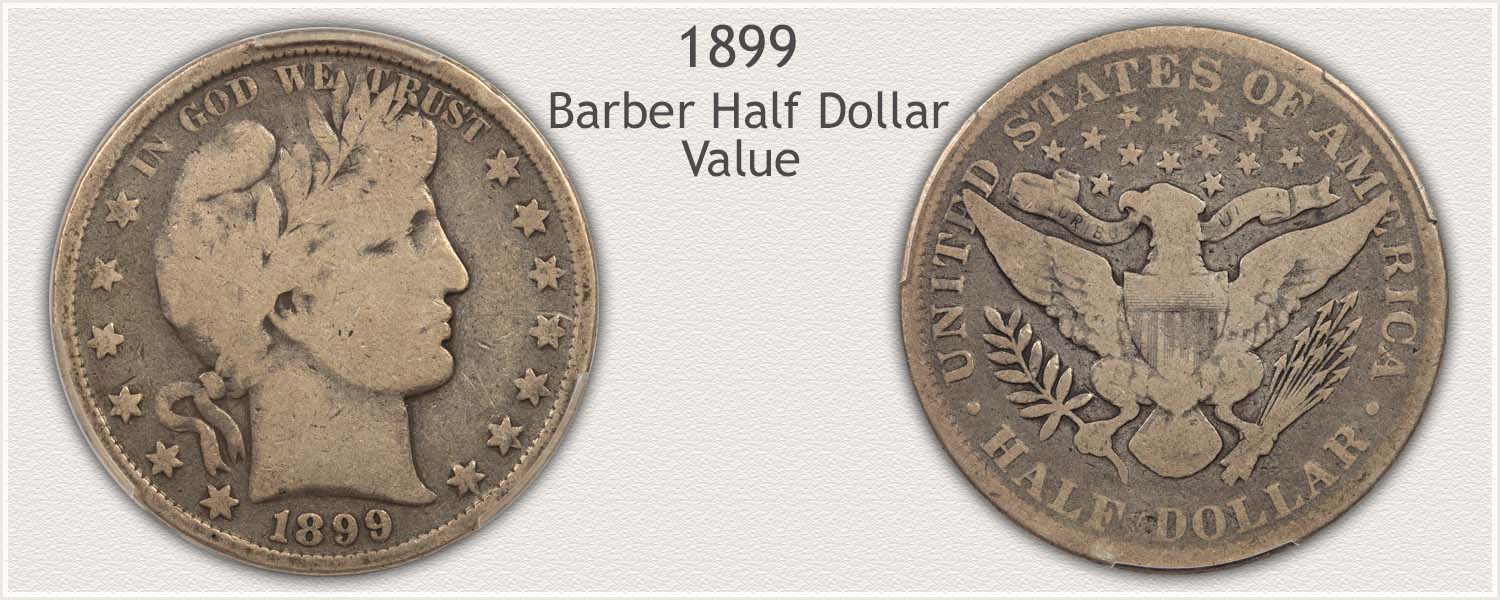
Steps Leading to Value:
- Step 1: Date and Mintmark Variety - An accurate description includes both the date of these old half dollars and the mint that struck the coin. Three different mints produced 1899 halves.
- Step 2: Grading Condition - Barber half dollars from the 1890's are quite elusive in high quality. Both dealers and collectors are interested in this coin. When it is a collectible grade, the coin has a premium value.
- Step 3: Special Qualities - Collectors are attracted to a Barber half displaying a pleasing appearance. High demand coins are identified by their qualities.
| 1899 Half Dollar Value | ||||
|---|---|---|---|---|
| Condition of Coin | ||||
| Date | Good | Fine | Extremely Fine | Mint State |
| Barber Half Dollar Values Updated | 4/7/2025 | |||
| 1899 | $17.92 | $60 | $157 | $376 |
| 1899 O | $24.06 | $95 | $213 | $1,106 |
| 1899 S | $21.61 | $42 | $117 | $2,016 |
In the chart, wholesale values are listed. These are used as a starting point. A dealer's needs and the specific condition of a half dollar are key factors.
Step 1: | Date and Mintmark Combination an Important Detail
Mint Varieties of This Special Year
Three mints across the country struck half dollar coins this last year of the century, each in different quantities. Availability of these different issues today shows a scarcity of halves in higher than heavily worn condition.
Popularity of the last coin of a century captures the attention of collectors. They strive to obtain an example from each mint variety of the year. Carefully inspect for mintmarks to assure an accurate reading of the value chart.
1899-S Barber Half Dollar
"S" Mintmark on Reverse: San Francisco Mint Struck the Coin
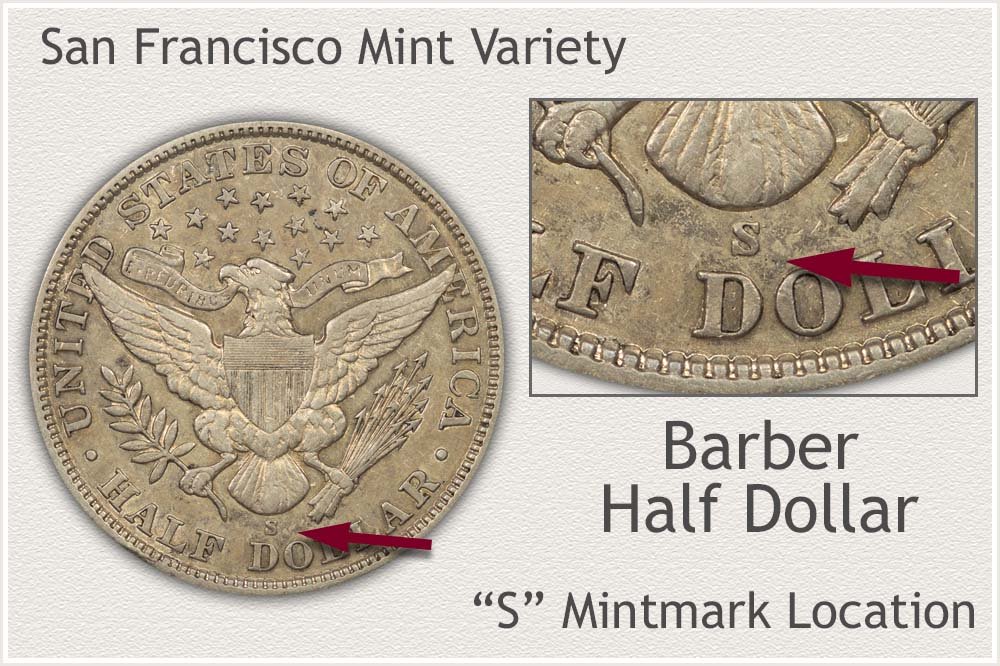
San Francisco variety half dollars were minted in the necessary quantities to meet commerce's demands in 1899. Production reached 1,686,411 coins. Significantly, heavily worn examples are plentiful today, and their value is influenced by the up and down movements in the silver price. However, examples that show only a trace amount of circulation wear are extremely uncommon. As shown on the chart, a close examination of their state of preservation is required. Identifying the mint variety and then determining the condition narrows down how much these coins are worth.
Helping maintain a strong demand is the alure of a large silver coin minted in a now long-ago century. 1899 halves are popular within the coin collecting community.
To identify its coinage, San Francisco added a "S" mintmark to all Barber half dollars. The San Francisco variety is identified by the letter "S" located on the reverse, just below the eagle.
1899-O Barber Half Dollar
"O" Mintmark on Reverse: New Orleans Mint Struck the Coin
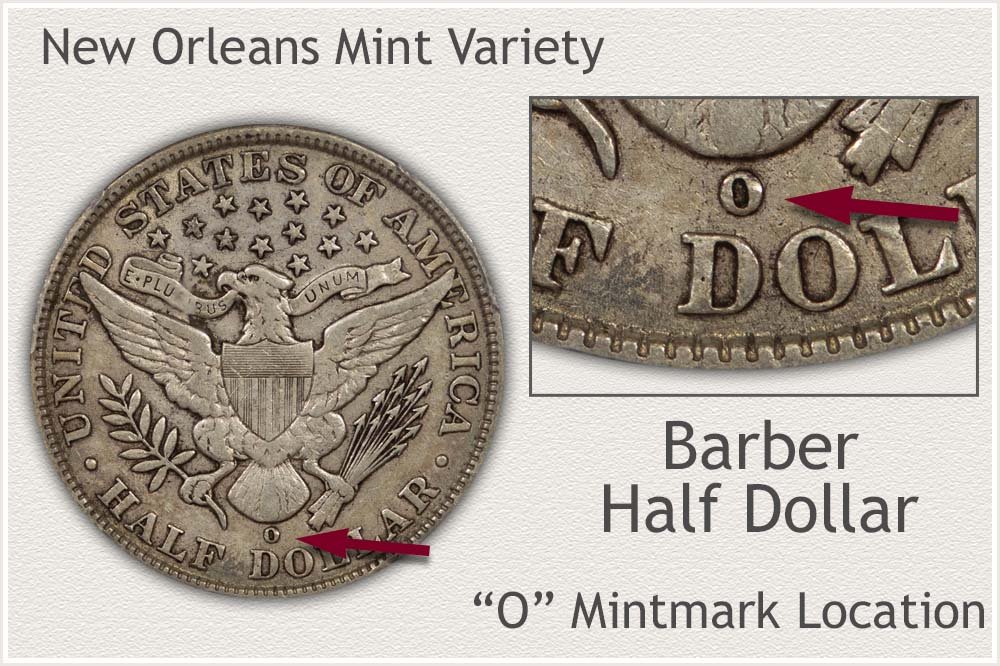
A series average of just over 1.7 million half dollars was produced by the New Orleans mint in 1899. Closing out the nineteenth century, these coins now represent a long-ago historical series of half dollars. Even though there were well over one million produced, this issue is challenging to find.
According to the premiums shown on the value chart, few were saved, notably in well preserved condition. All levels of preservation are highly sought by collectors. To accurately value early era Barber coinage today, a close examination is required.
Each branch mint has its own unique mintmark to distinguish its coins. An "O" mintmark appears on the reverse of New Orleans mint issues. Under the eagle, in the lower center, note an "O" confirming it is a New Orleans mint variety.
1899 Barber Half Dollar
No Mintmark on Reverse: Philadelphia Mint Struck the Coin
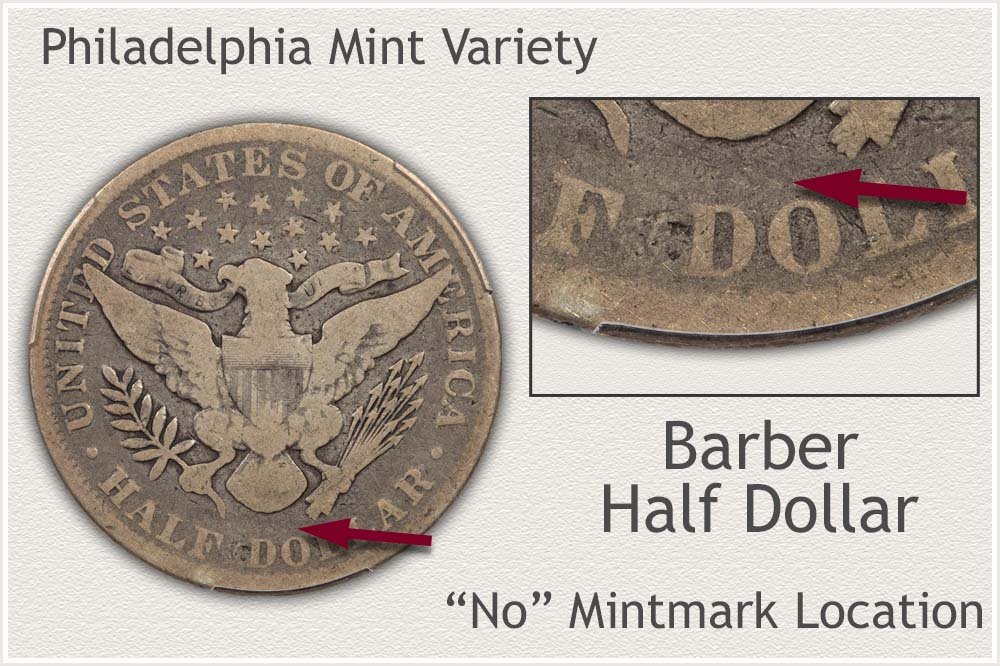
One of the Barber series' available dates is 1899 halves minted in Philadelphia. There were over 5.5 million halves minted. This went on to become the largest mintage year of the Philadelphia mint during the series. Quantities remain today. Value of these in heavily worn condition is based on their large silver content. During the time period, all half dollars contained 90% silver by weight.
Any 1899 half dollar recognized as above-average condition has the potential to increase in value. These are historic coins representing the last year of the century, always in demand. First, double-check the date and mint combination.
A lack of a mintmark on the reverse of the coin identifies Philadelphia Barber halves. The area beneath the Eagle and just above HALF DOLLAR on the reverse is empty. Philadelphia, serving as the primary mint for the United States, did not use mintmarks on its coinage.
Step 2: | Grading Inspects the Condition and Judges Preservation
1899 Half Dollar Value is Narrowed by Identifying Condition
Sharply detailed with small design features remaining is a collectible 1899 half dollar. Stages of wear are defined into different "grades". Using images and descriptions representing these stages determines a narrow condition range.
A large jump in value is seen on the chart for high quality preservation. Inspect the key areas to find an above average coin.
Mint State Grade
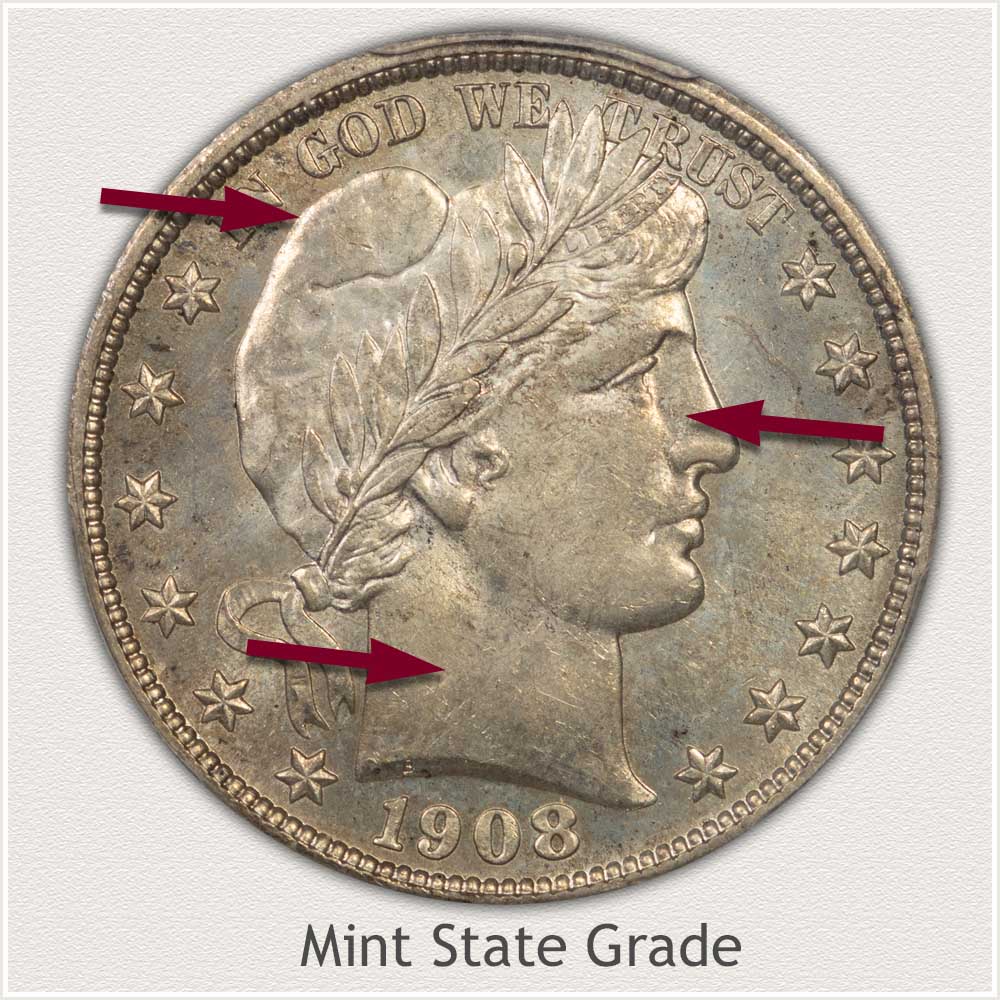
Mint State: Coins in excellent condition require careful handling. Be sure not to touch the surface of any coin by holding it by the edges. A coin is considered in mint state condition if there is no surface wear, and proper handling preserves this state of preservation. Grading is confirmed by closely inspecting the surface and judging areas that are likely to wear.
A well detailed portrait of Liberty is made up of large, open spaces (her cheek, neck, and cap) as well as smaller, more detailed elements (her hair, leaves, and headband). Her cheek and neck remain covered with luster, a fine grain texture. Wear in these areas dulls and smooths the surface, which is noticeable when compared to lower relief areas.
Condition of the coin is further determined by examining the cap atop Liberty's head. The metal surface in this high relief area still exhibits no smoothing or dulling and is still covered in luster.
Smaller and finer details of the leaves, all of which are full without any loss of detail, help when judging the coin's mint state grade. There is no smoothing or flattening of the inner raised contours, and the leaf edges are clearly defined.
Extremely Fine Grade
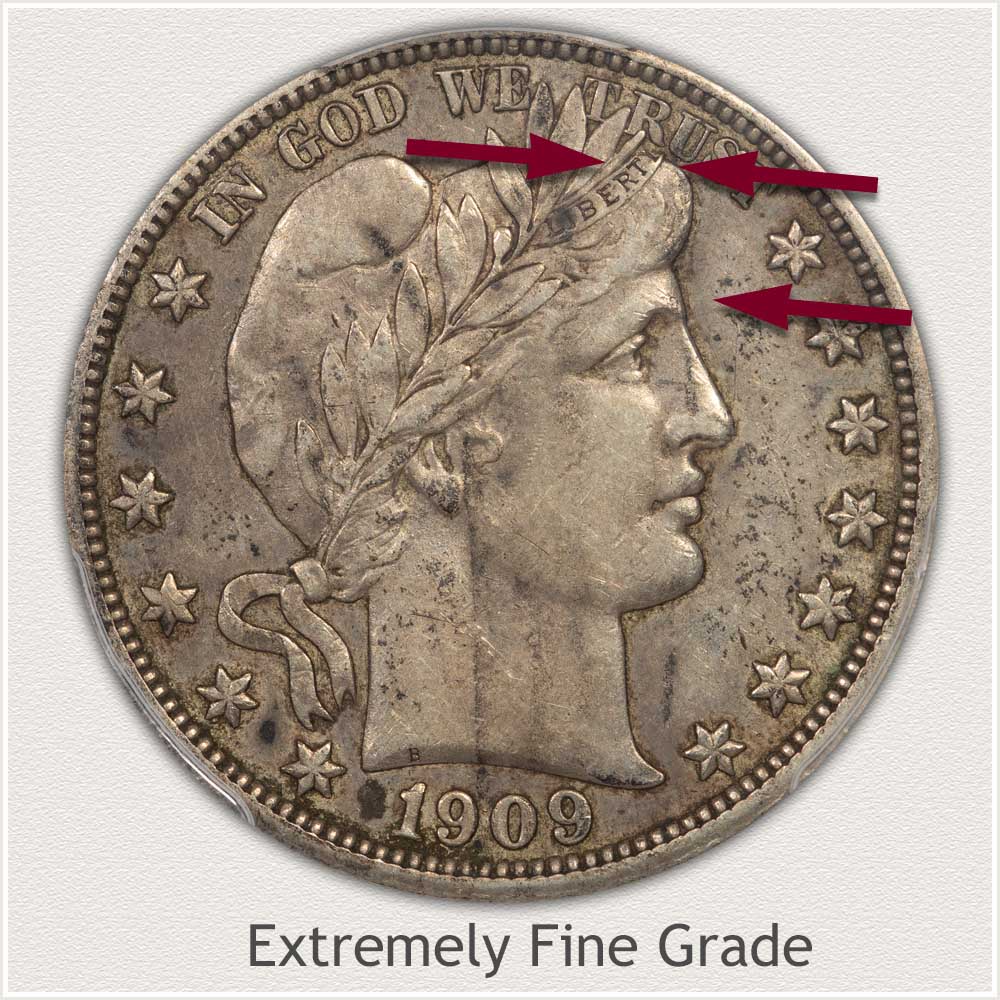
Extremely Fine: Finding a Barber half with fine details still visible helps determine whether the coin is in quality, collectible condition. A coin is considered in Extremely Fine condition when there is only very slight wear visible in small areas across its surface.
Overall, most of the original brilliance of luster is replaced by a soft silver-gray color on a lightly circulated half. Wear gives the metal a smooth surface, losing its luster. A close examination of Liberty's headband shows the word "LIBERTY" is visible in bold, clear letters. Additionally, and importantly, just above and below the lettering, a full, clear edge remains on the ribbon. Edges of this band are distinct and not merged with her hair and leaves.
Liberty's full portrait is well contoured, and all high and low relief areas are defined, adding to its collector appeal. The only flattened area is her eyebrow, while her cheek and neck display only minor smoothing. These coins are strong candidates for the Extremely Fine grade when they have a "crisp" appearance.
Fine Grade
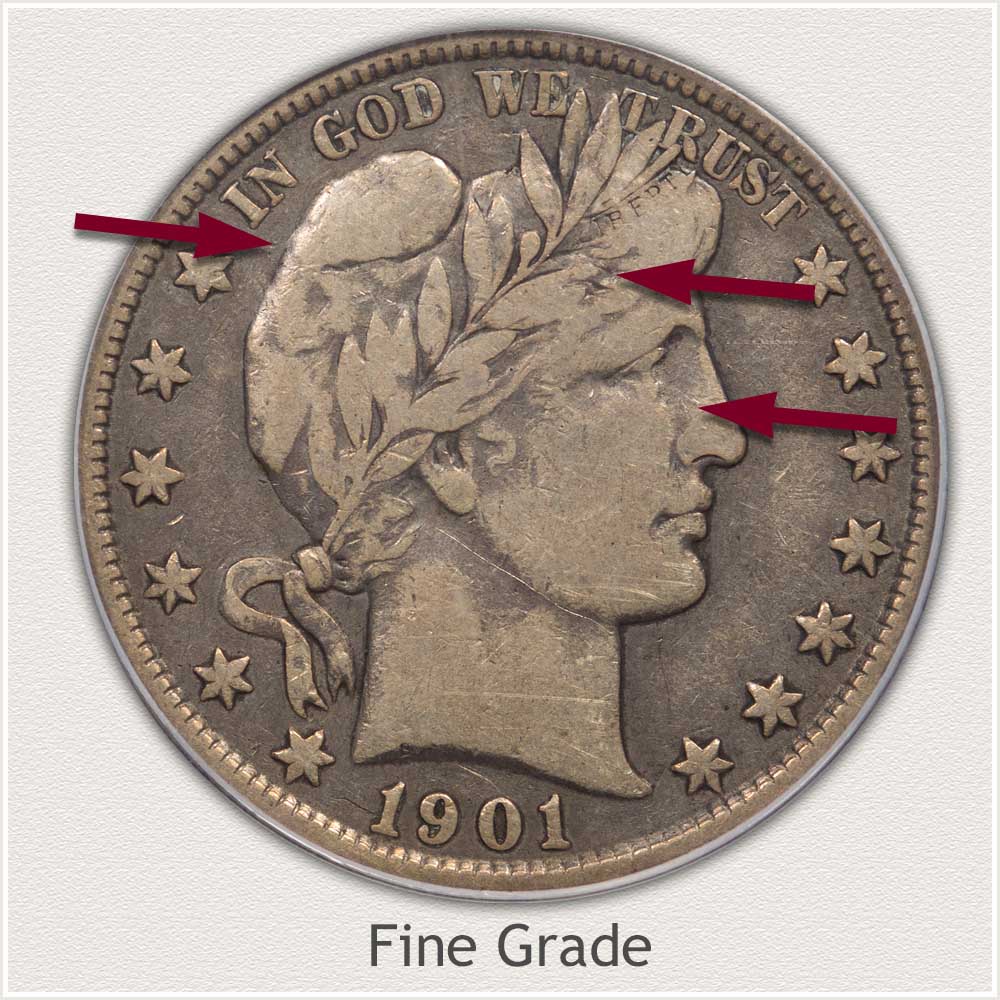
Fine Grade: Widespread interest in collecting these old half dollars extends into the Fine condition grade. Defining a Fine grade collectible coin is a combination of extensive visible detail remaining and signs of moderate wear. Liberty's cheek and neck are two examples of high points and open areas showing signs of wear on the example coin.
With continued use, the level of metal on Liberty's cheeks is gradually worn and reduced, resulting in flattened spots. Under her eye, as shown in the example, is a flat area that extends down to her jaw line and almost to her ear. Also, Liberty's cap shows flattened areas. It is possible to detect leaves above her head, also some hair detail extending towards her forehead. Details of her ear are very distinct.
Several fine design features of the wreath remain as well. Except where the leaves overlap, the upper row of leaves' edges are all intact. Furthermore, and key to earning the Fine grade, the word "LIBERTY" remains readable within the headband. It is these finer details of the design, such as lettering, leaves, and remaining contours, indicating a quality, collectible half dollar.
Good Grade
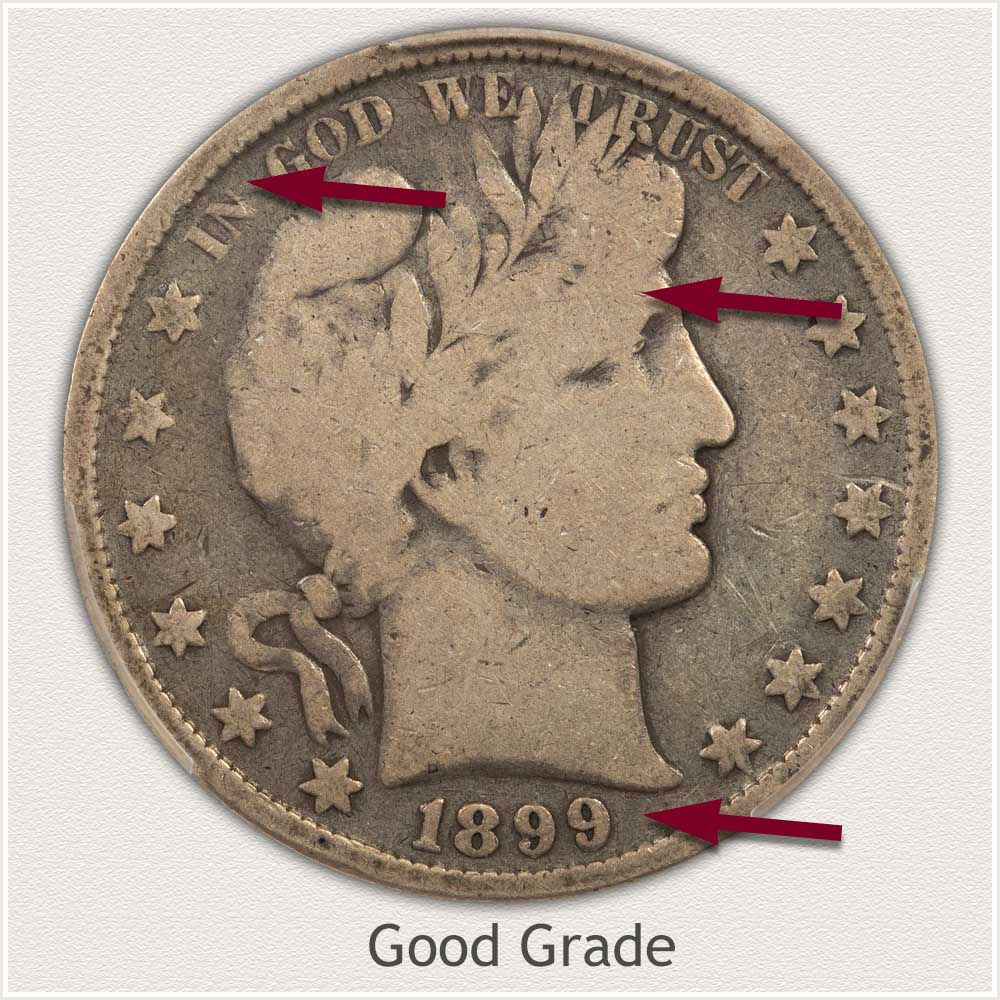
Good Grade: On a "Good" grade half, most high relief areas are smooth, missing detail, and worn near the level of the field. The grade is defined by the absence of minor design elements.
Looking just above Liberty's eye, there is no visible hairline along her forehead. This is a sign of significant wear, placing the example coin well within the Good grade range.
The coin's full rim, which is clearly separated from the stars and lettering at the top, is a requirement to achieve the grade. A bold, well-defined date is also required. Overall, there is a bold appearance to remaining details.
How to Video: Grading Barber Half Dollars
Highlighting additional areas to judge plus specific elements needed for each grade improves accuracy. Often, small details are of large importance when examining these vintage Barber half dollars.
Video, Images and Descriptions | Grading Barber Half Dollars
Step 3: | Special Qualities | Multiple Collectible Levels
Collectible Appeal of 1899 Half Dollars
Barber half dollars in nice, eye appealing condition are a difficult and expensive coin for collectors to acquire. 1899 halves because of affordability and remain an available coins to collect, are a special year in the series.
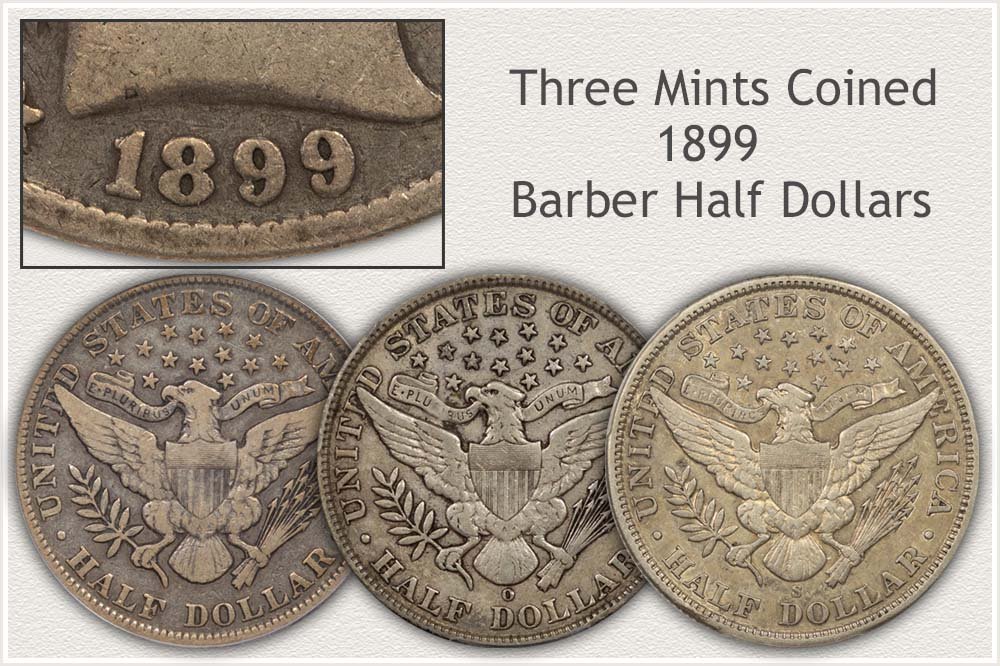 A Set of the Mints Coinage of Barber Half Dollars in 1899
A Set of the Mints Coinage of Barber Half Dollars in 1899
These old, large silver coins minted in 1899 have a strong silver base value. Also appealing to new collectors, prices of each are close to the affordable silver value. Three mint issues were struck, and all are within range to starting collectors.
Philadelphia 1899 halves are an abundant variety with ample supply to choose from. The San Francisco issue is similar in availability with the opportunity of finding pleasing examples.
A New Orleans half dollar of 1899 is coinage of a now obsolete mint. As part of a three-coin year set, it adds additional historical attention.
As interest and knowledge advance, collectors quickly pass the beginner stage and work on a complete date and mint collection. These vintage halves are part of the path for advanced collectors who seek examples in higher condition for top quality sets.
Now add in the alure of Nineteenth Century Coinage and many special qualities are part of 1899 half dollars. Barber coinage, a series from long ago, is now supporting new and advanced collecting interest. Old silver coins, collected at many levels, enjoying strong demand.
References
U.S. Mint. 1900 U.S. Mint Annual Report.
https://nnp.wustl.edu/library/book/320
U.S. Mint. Catalogue of Coins of the United States.
https://nnp.wustl.edu/library/book/554591
Coin Values | CoinStudy Articles
Date by Date
In Depth Barber Half Dollar Values
1892 to 1915
Barber Half Dollar Value | Importance of Condition
Early years of Barber half dollars, those minted 1892 to 1899, all have premium values in better than average condition. A full value chart points to these scarce coins with expanded condition examples to spot the premium coins.
Half Dollar Value | Large Range in Values
Value charts of the different half dollar series. Values have a large range depending on specific date, mint variety, and condition. Each series of half dollars is recognized by images linking to value charts and a process to narrow the range on the chart.
Coin Value Guide | How to Value a Coin Collection
Placing a value on a coin collection is a process of following a few steps. Identifying and judging your Barber half dollars continues with the rest of your collection. One step at a time, quickly evaluate, the entire group of coins. Images identify the different coin series; steps determine the key factors to an accurate place on the value charts.
Silver Coin Values | Minimum Values of U.S. Silver Coins
All U.S. dimes, quarters, half, and silver dollars minted before 1965 are heavy with silver. Each denomination and silver series is imaged and described to quickly recognize the premium coins. Using the calculator, determine how much vintage silver coins are worth currently. Silver prices change daily.
Popular Coin Series | Barber Half Dollars
Coin collections are assembled of the many different coin design series. Totals of Registry Set collections give an insight into popularity and potential demand. Collecting Barber half dollars is one theme many collectors enjoy.
★Coin Values Discovery finds 1899 Barber Half Dollar Value and...
All U.S. coin values. A starting point to correctly identify your old coin. Recognize the important features to value with a step-by-step process. Continue with a full evaluation of specific dates, mints, and condition.
